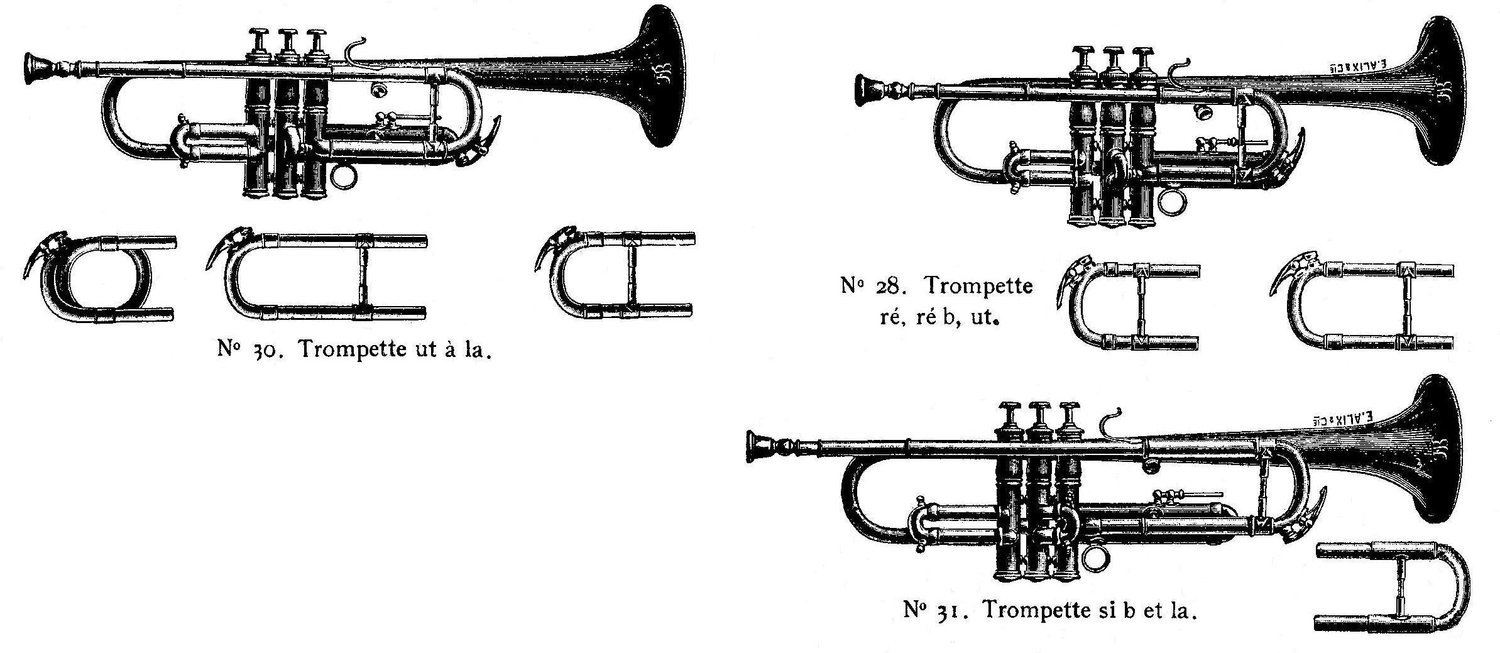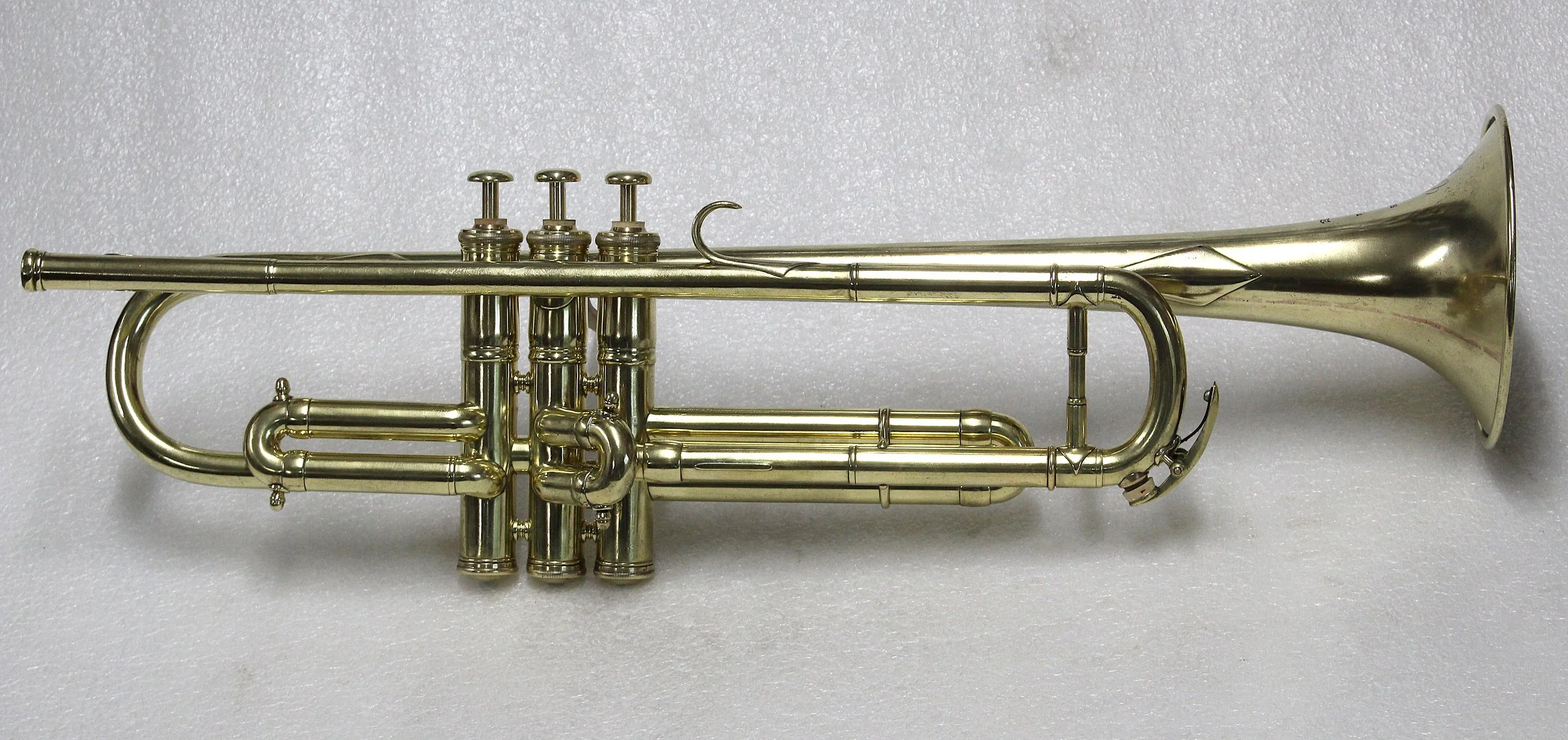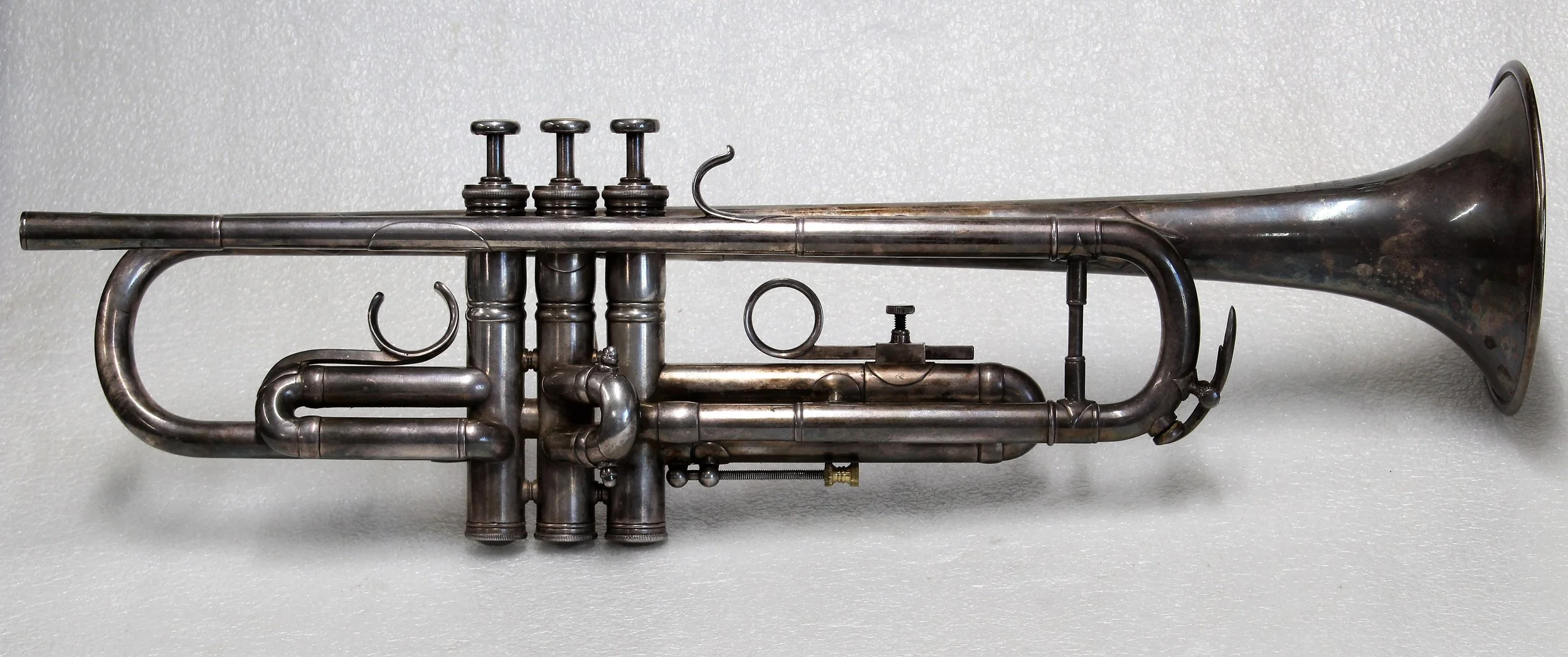Trumpet Schmumpet,
Some Facts and Observations on the Differences Between Trumpets and Cornets
Courtois Levy’s cornet, Fiske Orchestra cornet, Brown & Son F orchestra trumpet, Bach 7 trumpet and Conn New Wonder Cornet.
The purpose of this text and the accompanying chart is to increase, in a small way, understanding of certain properties of cornets and trumpets and especially to reduce misunderstandings that persist long after rational observation should have overcome conventional wisdom. Perhaps it is because of the fact that these are instruments of art and personal expression that it is easy to ignore empirical data and instead discuss mysterious qualities based on the perceptions that we have and anecdotal observations that we make of the device in our hands. It is an understandable desire to boil down a complex subject to seemingly understandable variables.
Many excellent articles have been written on acoustics of trumpets and cornets. I’ve appreciated the scientific approach, but even as the subject is being covered competently, there always seems to be a cloak of mystery just beyond the variables controlled for in the articles. Inaccuracies creep in, in the form of a misleading phrase or word or in the interpretation of data. Intentionally or not, assumptions are made regarding characteristics of trumpet acoustics that may or may not be affected by the variables being discussed. If information from sensory perception is studied, it must be gathered in a double blind manner with careful controls and then compare it to data from machine analysis. I expect that these topics will not warrant more thorough scientific study so we must continue studying the subject as best we can. While trying to make sense of our experience, it is just too tempting to apply the data without a direct correlation.
A good example that is very common in the discussion of trumpet characteristics is the acoustical properties of “air flow”. Acoustics are being confused with aerodynamics. Many trumpet players, using their perception of “air flow”, think that they can predict the bore measurement by playing an unfamiliar instrument. My experience with players of all kinds is that it isn’t possible and this is a good example of a discussion of trumpet design getting confused by the player’s physical experience.
If the bore size was the only measurable difference from an instrument familiar to the player this would be a rational discussion and I don’t want to overstate this concept. I’m quite sure that to an accomplished player, there is a perceptible difference between two trumpets of different bore sizes that are otherwise identical. However, I’ve had more than one good trumpet player tell me that they couldn’t use a Conn Connstelation model trumpet because the bore is too large and they don’t have the endurance that they have on a medium large bore trumpet. In reality, this and the famous Conn 22B have a bore measurement of .438” which is smaller than almost all trumpets models being made today. I assume that the perception of a large bore is both visual (the bell rim diameter is larger than almost all other trumpets at 5 1/8” and the curve of the main tubing is very wide) and acoustical, in that most of Conn’s designs from that time period were surprisingly efficient.
Other players perceive these trumpets as very easy to play and, as such, find their endurance on them excellent. It would seem to me that the most rational approach to trumpet (cornet) design would be to find the instrument that works best for the player and his/her circumstances without regard to measurements.
Pertinent to this essay, and often mentioned in articles and discussions on trumpet and cornet, is the comparison of the acoustical properties including timbre of cylindrical (trumpet) compared with conical (cornet) instruments. A quick look at the chart below demonstrates that this is a misconception to begin with. The chart shows length, in inches, of the main tubing making up various trumpets and cornets, listed by make and model. I tried to include instruments that were popular or common in their own era and considered to be good instruments. These are all Bb instruments excepting the last two, which are orchestral trumpets in G. In the case of high pitch instruments (old band pitch usually around A=452Hz), I measured only the high pitch set up, since that is the primary design in these cases.
Click on the chart below for larger view or click here for .pdf version.
The first column of numbers lists the length of the conical portion, which includes mouthpiece backbore, mouthpipe (only if conical) and bell. In some of the cornets, tuning crooks are conical and included in this column as well. The second column lists the length of the cylindrical tubing within the valves, tuning tubes, crooks etc. The third column lists the total length of the tubing (excluding the valve loops) from the start of the backbore to the rim of the bell. The last column lists the percentage of total tubing length which is conical in each instrument.
Years ago, when asked the difference between cornets and trumpet, I would say that a cornet starts out smaller and gets bigger in the end. I observed this to be true in some cornets but have since seen enough variability to stop using this generality. So, what is the difference between a cornet and a trumpet? The chart shows that a Bach cornet has 3% more conical tubing than a Bach trumpet and that a Schilke cornet has 5% less conical tubing than a Schilke trumpet. Averaging the percentage of conical tubing, the trumpets are 67 % and cornets are 66%.
Even though the study group is admittedly small and the choices not random, it appears that cornets and trumpets are designed pretty much the same in regard to length of conical tubing. I also realize that if I left out the earliest and presumably most archaic cornets, the average conical tubing length would be slightly higher for cornets. Still, they are almost the same. Based on my experience of more than 40 years working on brass instruments and specializing in old and unusual examples, this wasn’t at all surprising. What most surprised me was that in the only two 19th century G trumpets that I had access to during the time that I was measuring, both have similar portion of conical tubing to the rest of the study group. I have often stated that the old, longer trumpets were mostly cylindrical, but this shows it not to be so. The Courtois trumpets in G and F were largely favored for orchestral use in France, England and the US for the entire second half of the 19th century. In the catalog image below, the branch of tubing leading from the tuning slide to the third valve casing appears to be cylindrical, but actually has a slight taper as does the tubing through the crooks.
Courtois trumpets, 1897.
Considering natural trumpets from the early 19th century and before, they are indeed, mostly cylindrical. The few early 19th century valve trumpets in G or F that I have examined over the years are also mostly cylindrical. As we progressed into the cornet era the longer trumpets, apparently, were redesigned with conicity being an ideal. What is not shown in this chart, but obvious with visual examination, is that the G trumpets have very long and gradual conical sections ending in bell flares that are not much wider than those in modern Bb trumpets. Indeed, I have used modern trumpet bells on reproductions of a mid-19th century F trumpet with very good results. The gradually tapering tubing can be designed to manipulate the intonation of certain notes, but probably has no effect on timbre.
It is a logical conclusion that an important factor in the unique sound of the longer trumpets is that tubing is longer in relation to the mouthpiece size and that they are played in the mezzo-soprano rather than alto range as an alto trumpet of the same length. This is analogous to the French horn being the same length as the F tuba, but having its own sound that is distinct from the tuba with its much larger bore and lower range. The French horn is also very different from the alto horn and mellophone, which play in a similar range and have similar bore and mouthpiece size, but the length of tubing is half. But this is still not addressing the difference between the modern Bb trumpet and cornet.
Experienced trumpet players know that two examples of Bach 37 (or any other make and model) trumpets can have surprisingly different playing characteristics and can even sound noticeably different. Think also about the playing characteristics of the very same trumpet on a good day compared with a bad day. Most of us do have bad days. Or using a unfamiliar and uncomfortable mouthpiece. Using a Bach 7C mouthpiece on each, there is not much more difference than this between a Bach 37 trumpet and a Bach 37 cornet. I know that some will disagree with me, but I believe strongly that the biggest difference in this last case is the approach of the player. I have observed many times that the approach or belief of an individual player can affect the playing characteristics (including intonation and response) and sound of an instrument. Of course, the same weakness exists in both my statements and the conventional wisdom: nobody has done thorough studies to prove or disprove them.
We know that the mouthpiece design is very important to the playing characteristics of a cornet or trumpet. Those that have experimented know and the mouthpiece makers all tell us that the size and shape of the mouthpiece cup can have a relatively large affect on the timbre and other characteristics of the instrument. Most cornet mouthpieces made before 1920 have more or less funnel or “V” shaped cups as compared to the bowl or “C” shaped cups in the trumpet mouthpieces. In the last 60 years or so, most cornet mouthpieces have the same cups that are popular in those of trumpets (more traditional cornet cup mouthpieces have become more popular again in very recent years). In view of this, it is no surprise that we think of cornets as instruments of the past and trumpets of the present. Changing the mouthpiece for one of a different shape and/or volume in the cup is the quickest and easiest way to change the timbre of our instrument, whether trumpet or cornet.
A variation in the taper of the mouthpipe (commonly called “leadpipe”) doesn’t really make acoustical differences that affect the timbre of a brass instrument. It can, however, change intonation and response of certain notes or ranges of notes. The perception of these changes can, of course, change the approach of the player as discussed above. The longer, slower taper of most modern cornet mouthpipes can have noticeable affects in the playability, compared to the trumpet but not directly affect the sound. Closely related to this is the bore diameter of the tuning slide, valves, crooks and other cylindrical portions of the bore. Again, the design of these parts can affect the feel of the instrument. The extremes in my sample range from .425” in a small bore Conn Wonder cornet to .485” in the Conn Victor cornet and a few others. While using the same mouthpiece in each of these two cornets, the timbre is noticeably different, but not by a large margin. I am confident that the difference is to a small degree that bore difference, but more so in differences in the taper and flare of the bells.
Conn Wonder small, .425” bore and Conn Victor .485” bore.
What I have learned from experience is that there are two elements of instruments taper that are more significant than all others. The first doesn’t affect the timbre, but rather the intonation and is outside of the scope of this article: changing relative diameters of the tubing at the nodes and anti-nodes of the air column raises or lowers the pitch of the note or group of notes involved. The second is the shape of the final flare of the bell (the last 6 inches or so) and has significant influence on the sound produced. To demonstrate the extremes, I bring the flugelhorn or Saxhorn into the discussion. We all know how much difference in timbre there is between a trumpet and a flugelhorn. There are similar but smaller degrees of difference between trumpet and cornet bells of different shapes.
In all successful instruments the final portion of the bell has a more or less steadily increasing rate of taper up to the rim. On one extreme within the range of trumpet and cornet bell designs are a small and slow flare which nets a very bright or piercing timbre. This design had some popularity in the 1920s when trumpets were being used in popular music for the first time and similar bell flares were used in C and Eb trumpets.
Besson trumpets, 1910, in C and D with small bell flares and Bb with cornet style bell.
The other extreme is a wide and fast flare with a dark or warm timbre. The Olds Opera cornet, made in the 1960s and 1970s is about the most pronounced in this direction. Of course there have been many examples within the extremes. The most popular cornets of the last half of the 19th century were those made by Courtois and and many others that copied them, more or less. The Courtois had a relatively small bell flare by modern standards, but a fairly fast rate of flare in the last 4 inches. This rewarded the player and audience with a light but warm and sweet sound that becomes harsher when played very loudly.
Courtois Levy’s cornet and Olds Opera cornet.
The Besson cornet bell is surprisingly similar in actual measurements to 20th century Besson trumpet bells and all the other makes that were based on this highly successful design. It is not exaggerating to say that most popular trumpets today are based on the French Besson trumpet that was made before World War II and that, in turn, was based on the highly successful Besson cornet of the previous century.
The Besson cornet bell flares are slightly larger in diameter than the Courtois but with less flare in the last several inches. These have a more aggressive sound but still not overly bright and most modern players would likely find their characteristics to be more flexible or malleable than the Courtois.
Interestingly, there aren’t any current cornet models that copy the original Courtois bell flare (that I know of), but very many that are very similar to the Besson, including the Bach 37. There are, however, a few modern trumpets, such as the Getzen Canadian Brass and at least one Stomvi model and from the recent past, the Connstellation and medium bore Martin Committee, with bell flares somewhat similar to the Courtois cornet, although they are not nearly as popular as the Besson style. There are many examples of the much larger and darker sounding cornet bells which diverge from this historic precedent. I conclude two things from this: that the modern trumpet/cornet player typically favors a cornet sound that is either similar to his trumpet sound or larger and darker and that the Besson cornet became the Besson trumpet.
Interestingly, two of the best trumpet players that I know chose small bore Conn cornets from before 1910 when soloing and recording with the cornet. One of these players has used two of the smallest bore Conn cornets from the 1890s and 1900s for many live solos but in recent years has switched to using a Boston Three Star which is a very large bore and bell that was a copy of the original Courtois. I’m confident that even though these two cornets are at opposite ends of the cornet bore spectrum, they are each distinctly different from the trumpets that he uses. In the case of the other player he decided against using the small bore Conn for his recording project in favor of a modern Getzen cornet that he was more comfortable playing and could more easily get a perfect track down. This last instrument has a larger bell and darker sound than the trumpets that he uses. I don’t know in either of these cases if these players changed mouthpieces to suit each different cornet or if they use the same cup shape on trumpet and cornet but I thought that these were interesting anecdotes.
People believe what they want to believe and my views stated above are open for debate. My purpose with this discussion of facts and beliefs is to nudge the reader towards rational consideration of the evidence. Again, my conclusion is the same as in the second paragraph: it seems sensible (rational) to judge a trumpet or cornet on how it works for the player and his/her circumstances rather than on its particulars of design. There are many excellent instruments available today and a dizzying variety of mouthpieces. Many musicians do all of their work on one or two instruments and others, either by necessity or desire, choose from a wide range of trumpets and cornets that they keep ready. Some players are never happy with their equipment and others are always happy with their favorite instrument(s) and play them for decades or as the case may be, switch occasionally just for fun. The ideal, it seems to me, is to create a performance that is enjoyable and rewarding to the audience as well as the player.
Oh, and what is the difference between the trumpet and the cornet? I can only conclude that it’s more perceptual and subjective than academic.
Let me know if you have any considered thoughts on this subject.








